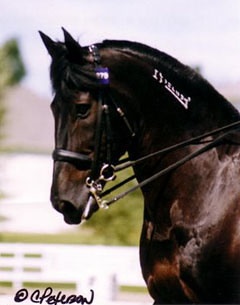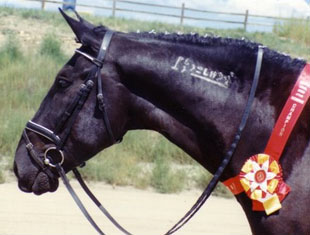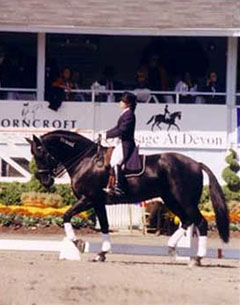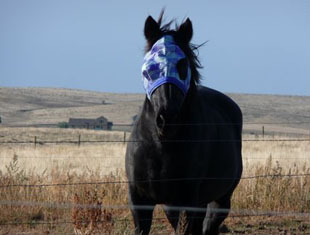
Dressage is nothing else than the cultivation of natural movements horses show in freedom and training these to perfection. Though there is no common definition what a dressage horse looks like, it undoubtedly should have tremendous presence, beauty and grace, outstanding paces and the ability to collect, moreover a certain kind of eagerness, intelligence and sensitivity.
For decades breeders all over the world try to breed the ideal horse for this discipline by using selected brood mares and stallions of the most proper bloodlines. And even with all these efforts it is far from easy to breed a good horse. Dressage riders look nearly everwhere to get a talented mount. A place where no serious dressage rider will ever look for a dressage hopeful is the jail, but this was exactly where a woman found a very special horse over 20 years ago.
This is the story of JB (=Jailbird) Andrew, a horse which never competed internationally, never won championships medals and still is one of the greatest oldies as he was the first mustang to reach the FEI level in dressage.
Mustangs may be the definite opposite of our meticulously bred warmblood horses: Their ancestors were horses, mainly Spanish ones, which were brought over when Europeans went to the North American continent in the 16th century. Some of these horses escaped and founded herds in the wilderness. They were rather small, but when early in the 20th century the farmers had the possibility to replace their heavy draft horses, like Percherons, by tractors they just sent them out in the wilderness. So these heavier and bigger horses crossed with the mustangs out there.
It was no different in Nevada, where the Bureau of Land Management (BLM) controlls the herds like in other States of the USA with mustangs. If there is less food for too many horses the BLM sends out helicopters to catch young mustangs. Interested people can „adopt“ them for a cheap price and give them a new home. Some of the caught mustangs are used for special rehabilitation programs for prisoners in jails, who break them in before they are offered for sale.
One of such mustangs was JB Andrew, which was caught as a weanling in Nevada in 1985 in a herd that was clearly influenced by Percheron blood as the horses were very big for wild horses. The black gelding was discovered by Ginger Scott in the State Prison of Colorado in Canon City in 1987 and adopted by her for 125 US dollars and a pair of cowboy boots for the prisoner, who broke him in.
"Andy" as he was called came to the Table Mountain Ranch boarding facility in Golden (Colorado) and for the reason he was a mustang he was put in a corral by himself to prevent other horses from becoming „wild horse“. But all this puzzled horse did was whinny because Andy felt abandoned by the whole world .
After Andy had settled into his new life Ginger's trainer thought the long striding horse could be a good dressage horse one day and Ginger was happy that another pupil of her trainer was willing to give it a try with her mustang. The student's name was Kelly O'Leary, a then young dressage rider who had her talented Morgan horse in the same stable. Because it was lame Kelly was quite happy she had a horse to ride, though it was „only“ a more or less unbalanced 4-year old mustang.
So Kelly started her work with Andy in the spring of 1989. She remembers how funny it was at the beginning: „Andy was like riding a rocking horse at the canter and he's kick at my outside leg when I asked for the canter depart.“ Anyway the jailbird named Andrew matured and improved from day to day and in his first show at the facility where he lived he won at first level against many quality warmbloods, which were bred for dressage. This was the point when Ginger and Kelly thought JB Andrew might have potential to stand against all these fancy horses in a discipline like dressage.
In 1990 Kelly had the opportunity to work with the renowned German born trainer Jan Ebeling and competed seriously on first level with her tamed mustang. Other mustangs had been competed at this quite easy level, but JB Andrew showed his outstanding talent by being 37th best of over 1500 horses competing at this level with the USDF.
Though improvement through his regular and varied training intitially didn't mean developing Andy's personality at the same time. „When I first started to work with him he didn't have much of a personality. He just stand tied and was quiet.“ Slowly this attitude changed and Andy more and more opened himself to people. He was and is a polite horse in the stable, but he loves to push his rider, who bought him later, around with his head to get attention.
The most important aspect of Andy's progressing dressage training, which he really enjoyed, was to get him strong. Of course he was trained in dressage, but Kelly also did a lot of trail rides and let him swim against the flow in the High Line Canal in summer. She taught him the sequence changes on the hill outside in a field.
This kind of training combined with daily freedom in the pasture kept the huge heavy horse motivated and eager.
In 1991 Andy had moved on to second level and at the end of the season he came 20th out of 1162 horses competing nationally at this level. A year later he even became the USDF reserve champion at second level in Region 5.
When Andy reached FEI level at the age of 9 in 1994 and started to do Prix St. Georges nobody would have guessed he was born in a herd in the wilderness of Nevada and broken in at a jail by prisoners. JB Andrew had matured into an impressive horse, standing 16,3 hh, properly muscled, shining black und full of power. Only his coldbrand made his past obvious. Moreover it seemed unbelieveable how elegant und fluently Andy moved with 1800 pounds of weight at this time.
 The year Andy started to compete at S-level the BLM made a trading card with his picture on it to use him as an ambassador for the mustang and promote mustang adoptions all over the country. That was the beginning of JB Andrew's mission to promote the horses of his kind by doing freestyles to music at exhibitions or western shows.
The year Andy started to compete at S-level the BLM made a trading card with his picture on it to use him as an ambassador for the mustang and promote mustang adoptions all over the country. That was the beginning of JB Andrew's mission to promote the horses of his kind by doing freestyles to music at exhibitions or western shows.
Kelly recalls Andy started to gather a fan club and recognized the attention of people, so he became more confident and proud of himself. He just knew by then everybody was there to watch him. Andrew had developed into a real personality by the time Kelly showed him in a national western stock show: „When Andy and I rode in the entire crowd roared and I have never felt a horse become so animated in my life. It was all I can do to stay on. I would say from then on Andy knew he was special.“
In 1995 Andy was established at Prix St. Georges level, but was out of work later in the year as he had hit hard the gate of his paddock and had a severe fetlock bruise, which ended the season earlier than intended.
Kelly's next aim was to get her black beauty the next step up the ladder and compete at Intermediaire I level. In 1996 she worked on Andy's strength the entire year and didn't start him. The time spent and the energy saved were well worth as 1997 became a special year for this remarkable pair. Andy made his debut at Inter I and did it in a very successful way by placing 125th out of 446 competitors nationally at this high level. But moreover he became the first and only mustang ever to attend at the USA's most meaningful dressage show, Dressage at Devon, where the country's best riders meet annually.
Andy wasn't there to compete, but once more to promote the mustang, so the whole long journey from Colorado to Pennyslavania was completely sponsored by the BLM.
Andy showed the expert audience a freestyle to music and he didn't fail to impress the cream of American dressage riders and the crowds alike. Who could resist this magnificient powerhorse with its tiny female rider?
In 1998 Kelly had to undergo surgery and was unable to ride much but in 1999 JB Andrew neared the Olympic level, the Grand Prix, and started at Intermediaire II level. He was doing the Grand Prix movements, loved the flying changes, but had to work hard on the canter pirouettes and the extrended trot as he is back at the knee and pigeon-toed.
 During the winter of 1999-2000 Andy injured his stifle and needed stall rest which caused him to have hock issues. For his rider there were two possibilities left: to undergo the quite painful hock surgery or the let the hocks fuse naturally, which meant the end of Andy's career as a dressage horse. Where many would have tried to bring such a talented horse back on the track at any price Kelly decided against it and chose for her equine friend.
During the winter of 1999-2000 Andy injured his stifle and needed stall rest which caused him to have hock issues. For his rider there were two possibilities left: to undergo the quite painful hock surgery or the let the hocks fuse naturally, which meant the end of Andy's career as a dressage horse. Where many would have tried to bring such a talented horse back on the track at any price Kelly decided against it and chose for her equine friend.
She sent him out in the pasture, where he taught two-year old manners. Andy proved to be very successful in his second career, too.
Such an outstanding horse had to have an official retirement ceremony, of course. When Andy was much better he got his during the Dressage at the Rockies II show in August in 2001. Pictures show Kelly leading her black gentle giant unsaddled and with a white flower wreath out of the arena, a very moving moment for many attached to him in one or the other way. For the very last time this very special horse, of whom Breyer even did at model in 1996, one of the first of a still living horse, was enjoying the undivided attention of masses of people.
Now, eight years after Andy left the limelight, he is still the centre of attention in his longtime rider's life. He knows Kelly inside out, recognizes her car and comes to the fence to greet her every day. As soon as Kelly calls Andy's name he runs out of his shed and whinnies loudly for his beloved „mummy“. Kelly has worked with another mustang and she found there is a deeper bond with them than with a "domestic" horse.
"I find that they bond with you like a dog would and you become their person," she said. There is no doubt Andy is a once in a lifetime horse for Kelly, who strongly believes „it is the heart that makes the horse, not a particular breed.“
Andy is almost 25 now and loves to be groomed and pampered. But in the summer of 2009 a malignant carcinoma was found between Andy's right eye and his skull. Kelly does everything possible to keep her horse comfortable as long as possible. The black gelding wears a flymask all the time, but as Kelly explains, "the prognosis is not good. The tumor can go into his brain and make him neurological."
 Andy, who was inducted in the Wild Horse and Burro Hall of Fame in 2002, is currently obsessed with eating grass outside his pasture and thinks his grazing time should be much longer as he won't let Kelly get his head up from the grass.
Andy, who was inducted in the Wild Horse and Burro Hall of Fame in 2002, is currently obsessed with eating grass outside his pasture and thinks his grazing time should be much longer as he won't let Kelly get his head up from the grass.
JB Andrew's longtime owner loves him dearly after all they had experienced and achieved together over the past 20 years. "He means so much to me," Kelly stated. "He will let me know when it's time. But it makes me cry every time I think about it."
If the time has come for the most magnificient mustang ever to gallop freely over the everlasting pastures he will leave a big vacuum, but also wonderful memories in the hearts of those closest to him and those who had the honour to see and meet an unforgetable horse.
Article by Silke Rottermann
Silke Rottermann likes to thank Kelly O'Leary for all her help in writing this article.
Photo courtesy: Cathie Peterson, Dave McRitchie, Brian Soule and Mary Phelps
Related Links
Fighting Windmills: Friesian Style
Fighting Windmills: Stardust 7 Margin, a Haflinger at S-level